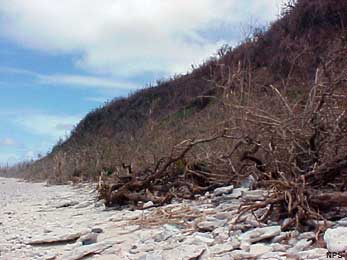Climate change poses a unique set of issues for Pacific islands
Though the impacts of climate change are observed around the globe, the geology and climate of the Pacific islands lead to unique challenges. For example, sea level rise increases flooding, saltwater intrusion makes less water available for drinking, bleaching and ocean acidification reduce the natural habitat and protective qualities of the coral reefs, and rising sea temperatures creates more cyclones and other extreme weather.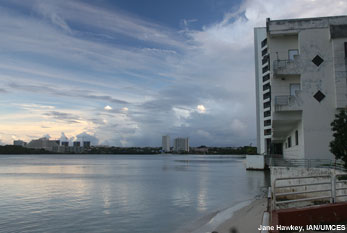
Sea level rise will increase flooding
As the earth warms, melting ice caps aren't the only source of global sea level rise. When heated, the molecules in ocean water move faster, move apart, and take up more space. Thus, with rising sea temperatures, the ocean undergoes thermal expansion. From 1993 to 2003 sea level across the globe increased by an average of 3.1 mm per year (IPCC 2007) and as climate change continues, sea level rise will continue to cause more coastal flooding.Sea level rise is of particular importance to people in the Pacific islands because most people on islands tend to live on the coast or in flood zones. Thus, people, homes, roads, farms, and buildings are threatened by rising waters during times of floods. As climate change progresses and sea level continues to rise, the people and resources along the coasts will be inundated with ocean water.
Corals are also threatened by sea level rise. Corals live in relatively shallow waters where they receive plenty of light. As sea level rises and the ocean gets deeper, light will not reach the corals that currently live at the deepest depth they can tolerate. Over time, these corals will receive less and less light, and eventually die (Hoegh-Guldberg 1999).
Saltwater intrusion will make less water available for drinking
Below the porous rock of some Pacific islands, aquifers hold freshwater that islanders depend on for drinking. Porous rock also allows saltwater to seep through. Where the salt and freshwater meet, there is a layer of brackish (slightly salty water). As sea level rises, ocean water moves into the aquifer, raises the level of brackish water in wells, and makes less freshwater available for drinking. This is called saltwater intrusion. As a result, wells that were once able to draw water from the aquifer are becoming increasingly salty. Complicating the issue is the growing demand for water. As island populations grow, more and more freshwater for drinking, for irrigating farms, and for maintaining development such as golf courses is pulled from aquifers. When more water is pulled from the aquifer than rain can naturally replace, then saltwater moves in to fill the aquifer—making the water even saltier. Thus, pressure on aquifers comes from both sea level rise and intense water use.
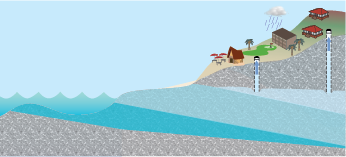
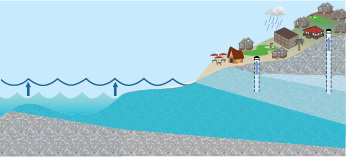
Bleaching and ocean acidification will reduce coastal protection
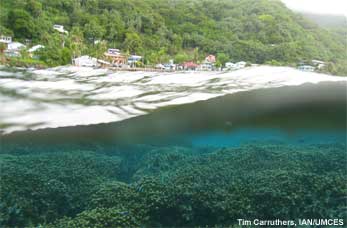 Coral reefs not only provide marine habitat for fish and invertebrates, they also protect coastlines from pounding waves often generated by storms. By absorbing some of the force of these waves, coral reefs protect people and property along the coast. When coral reefs are healthy, they can grow quickly and recover from these violent events. However, if coral reefs are unhealthy or stressed, they cannot grow fast enough to recover and will not be able to protect the coast during the next storm with strong waves.
Coral reefs not only provide marine habitat for fish and invertebrates, they also protect coastlines from pounding waves often generated by storms. By absorbing some of the force of these waves, coral reefs protect people and property along the coast. When coral reefs are healthy, they can grow quickly and recover from these violent events. However, if coral reefs are unhealthy or stressed, they cannot grow fast enough to recover and will not be able to protect the coast during the next storm with strong waves. As ocean temperatures continue to rise, bleaching and ocean acidification will severely stress corals making reefs less and less healthy which will results in a loss of reefs (IPCC 2007). For example, bleaching stresses corals making reefs more vulnerable to storms, and ocean acidification actually erodes the corals that make up the reefs. In the future, coral reefs will not provide the coastal protection we rely on today.
Rising sea temperatures will create more cyclones and other extreme weather
Climate change alters weather patterns in the Pacific. Warmer ocean water drives more intense storms over Pacific islands (Governor's Coral Reef Advisory Group 2007). These storms and cyclones will erode coastlines, destroy the coral reefs that protect coasts, dump large amounts of potentially flood-causing rain, and generate winds that can damage property (Minura et al. 2007). While it is true that Pacific islands have weathered cyclones in the past, climate change will cause more frequent and more severe weather to strike the islands in the future.